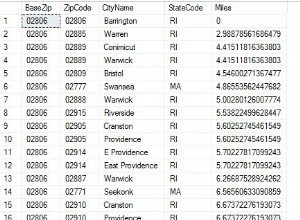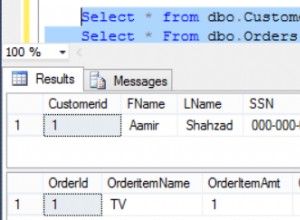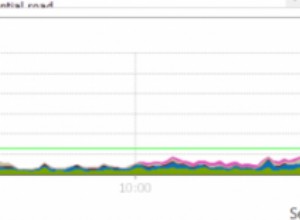Możesz użyć unpivot/pivot, aby uzyskać żądany wynik. Istnieje kilka różnych sposobów uzyskania wyniku, jeśli masz ograniczoną liczbę wartości, możesz na stałe zakodować zapytanie, ale jeśli masz nieznaną liczbę wartości, będziesz musiał użyć dynamicznego SQL.
Proces UNPIVOT skonwertuje wiele kolumn c1 itp. w wielu wierszach. Gdy dane znajdą się w wielu wierszach, możesz łatwo zastosować funkcję PIVOT. Możesz użyć funkcji unpivot lub CROSS APPLY, aby przekonwertować dane z wielu kolumn:
select id,
col = 'Service'+Service+'_'+col+'_'+cast(seq as varchar(10)),
value
from
(
select id, service, c1, cn
, row_number() over(partition by id
order by service) seq
from yourtable
) t
cross apply
(
select 'c1', c1 union all
select 'cn', cn
) c (col, value)
Zobacz Skrzypce SQL z wersją demonstracyjną . Zastosowanie krzyżowe spowoduje konwersję danych do formatu:
| ID | COL | VALUE |
| 1 | ServiceA_c1_1 | 5 |
| 1 | ServiceA_cn_1 | 3 |
| 1 | ServiceB_c1_2 | 2 |
| 1 | ServiceB_cn_2 | 1 |
| 2 | ServiceA_c1_1 | 9 |
| 2 | ServiceA_cn_1 | 4 |
Gdy dane będą w tym formacie, możesz zastosować PIVOT:
select id, ServiceA_c1_1, ServiceA_cn_1,
ServiceB_c1_2, ServiceB_cn_2
from
(
select id,
col = 'Service'+Service+'_'+col+'_'+cast(seq as varchar(10)),
value
from
(
select id, service, c1, cn
, row_number() over(partition by id
order by service) seq
from yourtable
) t
cross apply
(
select 'c1', c1 union all
select 'cn', cn
) c (col, value)
) d
pivot
(
max(value)
for col in (ServiceA_c1_1, ServiceA_cn_1,
ServiceB_c1_2, ServiceB_cn_2)
) piv;
Zobacz Skrzypce SQL z wersją demonstracyjną .
Następnie, jeśli masz nieznaną liczbę wartości, możesz przekonwertować powyższe zapytanie na dynamiczny SQL:
DECLARE @cols AS NVARCHAR(MAX),
@query AS NVARCHAR(MAX)
select @cols = STUFF((SELECT ',' + QUOTENAME('Service'+Service+'_'+col+'_'+cast(seq as varchar(10)))
from
(
select service,
row_number() over(partition by id
order by service) seq
from yourtable
)d
cross apply
(
select 'c1', 1 union all
select 'cn', 2
) c (col, so)
group by seq, Service, col, so
order by seq, so
FOR XML PATH(''), TYPE
).value('.', 'NVARCHAR(MAX)')
,1,1,'')
set @query = 'SELECT id, ' + @cols + '
from
(
select id,
col = ''Service''+Service+''_''+col+''_''+cast(seq as varchar(10)),
value
from
(
select id, service, c1, cn
, row_number() over(partition by id
order by service) seq
from yourtable
) t
cross apply
(
select ''c1'', c1 union all
select ''cn'', cn
) c (col, value)
) x
pivot
(
max(value)
for col in (' + @cols + ')
) p '
execute sp_executesql @query;
Zobacz SQL Fiddle z wersją demonstracyjną . Oba dadzą wynik:
| ID | SERVICEA_C1_1 | SERVICEA_CN_1 | SERVICEB_C1_2 | SERVICEB_CN_2 |
| 1 | 5 | 3 | 2 | 1 |
| 2 | 9 | 4 | (null) | (null) |




